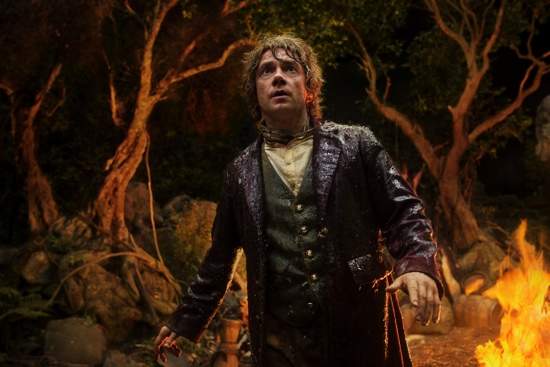It’s been nearly ten years since Middle Earth unfurled across the screen, and in that time, the Lord of the Rings films have cemented their place in cinematic history. The actors have aged, technology has evolved, and the influence of Peter Jackson’s trilogy is evidenced in all the three-plus-hour epics we’ve seen over the past decade.
Jackson slips back into this world seamlessly, elevating the grandeur but also reigning it in; instead of army battles and global chaos pitting kings against wizards and demons, this is a merrier tale of Bilbo Baggins, Gandalf, and a band of dwarves hunting a lost treasure guarded by the fierce dragon Smaug.
Smaug, we’re told (and cleverly not shown until the very end) attacked the thriving dwarf city of Erebor years ago, evicting dwarven kind from their homeland (writing that I’m starting to wonder if there’s a parable here, big noses and all…) and forcing them to have it out with every other race in Middle Earth, from the orcs at Moria (the chief of whom kills the leader dwarf, Thorin’s, grandfather and becomes the main antagonist) to the elves at, uh, Elvania (the elves chose not to help the dwarves in the battle against Smaug).
Some do it for honor, some excitement, and some for good-old cash. Tolkien’s book was of course smaller in scope: The Hobbit was high adventure while The Lord of the Rings was a world-spanning battle between good and evil. Thus the stakes are lowered, but all the richness of Jackson’s interpretation of Middle Earth is still there. Familiar places and characters are revisited, as are musical themes and cues. And Jackson is always in the background adding little and sometimes expansive scenes that set up the events in Lord of the Rings, but he still keeps it small enough that when the series is completed, it will likely not only be its own story but also a progression to the next.
Likewise, though it’s been a few years since I last saw the Lord of the Rings films, the special effects here seem to have the same look and feel to them — as if Jackson preferred to keep a consistent look instead of the polish he probably could have gotten. The trolls have the same smoothness and sparse detail of the troll in Fellowship; the eagles and wargs show their seams; and the orcs are as ugly as they ever will be.
The same actors haven’t aged much either, so the differences of 10 years’ time are not blindingly apparent. Elijah Wood is ageless and Ian Holm has the same wrinkles and gray to white ratios for his several scenes. Martin Freeman as Bilbo is also perfect as the definitive hobbit, worthy of all the charm and satisfaction in simple pleasures Holm brought to the role. Ian McKellan returns as Gandalf, less sullen and stern and more playful but still with a touch of craftiness. And Andy Serkis is back as Gollum, going hammy in the one-sided conversations but nevertheless capturing the same menace but moreso the despair. Several other familiar faces make an appearance, but I won’t spoil them.
For the newcomers, Richard Armitage as Thorin Oakenshield is the most noteworthy. As the hero he’s prettied up and believable enough, but there’s little to distinguish him from Viggo Mortensen save for some Hobbit prejudice that’s resolved soon after it’s brought up. And fans of Doctor Who will be pleased to see Sylvester McCoy in an extended sequence as Radagast the Brown. His scenes are all new and played more for comic relief (I’m pretty sure that stuff on the right side of his face is exactly what you think it is).
Ken Stott as Balin also stands out as the wise man among the dwarves, adding some levity and character to a group that has few distinguishing characteristics. The rest of the dwarves have their own personalities, and I think Jackson has given them more than Tolkien ever did, but I hope they’re expanded upon in the subsequent films. At least the choice to cast several Scots and Irishmen in the parts is inspired.
Of course the film has its flaws — as comfortable as Jackson is in Tolkien’s fantasy he hasn’t lost the tendency to pad, and many scenes, particularly early on, feel unnecessary and drawn out. I’d be perfectly happy to watch the dwarves wash dishes instead of seeing Bilbo waffle back and forth on whether he wants to join up for a half hour. And the last hour in the cave shares many similarities to the last hour in Fellowship, but then again, it’s the best part of the film.
In all, The Hobbit could use a trim, and while I didn’t see it in the higher frame rate, it wouldn’t be difficult to get me back in the seat for a revisit of this unexpected delight.

